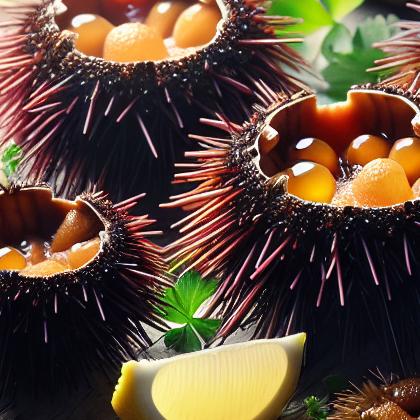Sea Urchins

Sea urchins or urchins (/ˈɜrtʃɪnz/), archaically called sea hedgehogs, are small, spiny, globular animals that, with their close kin, such as sand dollars, constitute the class Echinoidea of the echinoderm phylum. About 950 species of echinoids inhabit all oceans from the intertidal to 5000 m deep. The shell, or "test", of sea urchins is round and spiny, typically from 3 to 10 cm (1.2 to 3.9 in) across. Common colors include black and dull shades of green, olive, brown, purple, blue, and red. Sea urchins move slowly, and feed on mostly algae. Sea otters, starfish, wolf eels, triggerfish, and other predators hunt and feed on sea urchins. Their roe is a delicacy in many cuisines. The name "urchin" is an old word for hedgehog, which sea urchins resemble.
Sea urchins Pairs With:

Sea urchins Properties:
| Food Property | Type | Description |
|---|---|---|
| Flavor Profile | Umami | Sea urchins have a strong umami flavor due to the presence of glutamate. |
| Nutritional Value | Macronutrients | Sea urchins are a good source of protein and healthy fats. |
| Micronutrients | Sea urchins are rich in vitamins and minerals such as vitamin D, vitamin B12, and zinc. | |
| Color | Natural Pigments | Sea urchins have a vibrant orange color due to the presence of carotenoids. |
| Aroma | Volatile Compounds | Sea urchins have a briny and oceanic aroma that is characteristic of seafood. |
| Chemical Composition | Acidity/Alkalinity (pH) | Sea urchins have a slightly alkaline pH level. |
| Cooking Behavior | Heat Conductivity | Sea urchins cook quickly and are best served raw or lightly cooked to preserve their delicate flavor and texture. |
Food Pairing App - Version 1.2.0
